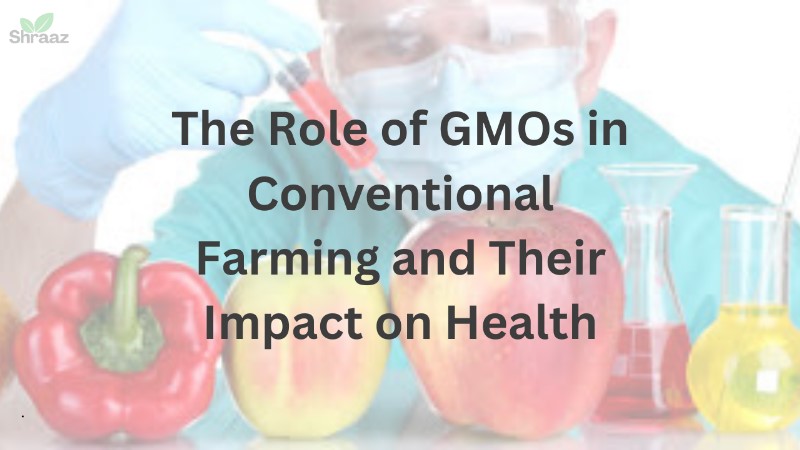Introduction to Role GMO’s
Genetically Modified Organisms (GMOs) have played a transformative role in modern agriculture since their introduction in the 1990s. As the global population continues to grow, conventional farming has adopted GMOs to increase yields, enhance crop resilience, and improve food security. However, the use of GMOs remains a controversial topic, with concerns about their long-term impact on both human health and the environment. This article explores the role GMOs play in conventional farming, their benefits, challenges, and the ongoing debate surrounding their safety and health implications.
For a broader discussion of the overall organic products beyond just GMOs in Conventional Farming , check out Organic vs. Inorganic Farming: A Comprehensive Comparison.
The Role of GMOs in Conventional Farming
Historical Context of GMO Use in Farming
The first genetically modified crops were developed in the early 1990s, with the primary goal of improving crop resistance to pests, diseases, and environmental conditions. By 1994, the Flavr Savr tomato became the first genetically engineered food to be approved for sale in the U.S. Since then, the adoption of GMOs in conventional farming has rapidly expanded, with millions of hectares of land worldwide devoted to GMO cultivation.
By 2020, the adoption of GM crops covered nearly 190 million hectares globally, with the U.S., Brazil, Argentina, and Canada leading production. These countries focused primarily on major crops like corn, soybeans, cotton, and canola, which have been genetically engineered for traits such as herbicide tolerance and insect resistance.
Types of GMO Crops in Conventional Farming
GMO crops in conventional farming are primarily designed for two traits:
- Herbicide Tolerance: These crops are engineered to withstand herbicides like glyphosate, allowing farmers to use chemical weed control without harming the crop. Examples include Roundup Ready soybeans, which have significantly reduced the need for tilling and helped preserve soil structure.
- Insect Resistance: Crops like Bt corn produce a bacterial protein that is toxic to certain pests, reducing the need for chemical insecticides. This has led to a marked decrease in pesticide use, benefiting both the environment and farmworkers’ health.
Other genetically modified traits include:
- Drought resistance.
- Enhanced nutritional content, such as the development of Golden Rice, which is fortified with vitamin A to combat malnutrition.
Benefits of GMOs in Conventional Farming
The adoption of GMOs in conventional farming has brought significant benefits:
- Increased Crop Yields: GMOs can withstand harsher environmental conditions and are less susceptible to pests, leading to more reliable and higher crop yields. For example, a meta-analysis published by Nature in 2014 showed that GMO crops increased yields by 21% on average.
- Reduction in Pesticide Use: Insect-resistant GMOs like Bt crops have reduced the need for chemical pesticides. From 1996 to 2016, farmers using GM crops cut their pesticide use by 8.1%, reducing the environmental impact of harmful chemicals.
- Improved Food Security: GMOs have helped stabilize food production in regions vulnerable to crop failure due to droughts, pests, or poor soil quality. For example, drought-resistant GM maize has been introduced in parts of Africa, where it has increased resilience to changing climate conditions.
- Economic Benefits: In 2018 alone, farmers growing GMOs saved $19 billion through increased efficiency and reduced input costs (such as pesticides and labor).
Controversies and Concerns Regarding GMOs in Farming
Despite these benefits, GMOs remain controversial, particularly regarding their environmental and economic impacts:
- Environmental Impact: There are concerns that widespread use of herbicide-tolerant crops has led to the rise of “superweeds”, which have developed resistance to glyphosate. As a result, farmers have been forced to use additional or more potent herbicides to control these resistant weeds.
- Cross-Contamination: There is a risk of GMO crops cross-pollinating with non-GMO or organic crops, which could affect biodiversity and organic farming standards.
- Monopoly Concerns: A few large agribusinesses control the patents on GMO seeds, leading to concerns over the concentration of market power. Farmers who use GMO seeds often sign contracts that restrict seed saving and replanting, which can place financial pressure on small-scale farmers.
The Impact of GMOs on Human Health
Nutritional Profile of GMO vs. Non-GMO Foods
One of the most common questions regarding GMOs is whether they alter the nutritional value of food. Studies have found no significant differences in the nutritional content of GMO and non-GMO foods. For example, Golden Rice, a GMO crop, was specifically engineered to address vitamin A deficiency in developing countries, showing that GMOs can improve the nutritional quality of food.
Safety of GMOs: Scientific Consensus
The scientific consensus is that GMOs are safe for human consumption. Major organizations like the World Health Organization (WHO), Food and Drug Administration (FDA), and European Food Safety Authority (EFSA) have concluded that GMOs on the market pose no greater risk to human health than conventional crops.
A 2016 report by the National Academies of Sciences analyzed over 900 studies and found no substantiated evidence that GMO crops are harmful to health or that they have caused environmental problems.
Health Concerns and Myths Surrounding GMOs
Despite scientific consensus, there are persistent health myths about GMOs:
- Allergies: Some fear that genetically modified foods could trigger new allergies, but research has shown no evidence that GMOs have caused an increase in allergic reactions. GMO crops are rigorously tested to ensure they do not introduce allergens.
- Cancer: Claims that GMOs are linked to cancer have been debunked. Extensive reviews by institutions like the American Cancer Society have found no connection between GMO consumption and cancer incidence.
GMOs and Food Labeling
In many countries, labeling GMO products has become a major issue. In the U.S., the National Bioengineered Food Disclosure Standard requires companies to disclose bioengineered ingredients, while in the European Union, GMO products must be clearly labeled.
Labeling gives consumers the right to know what’s in their food, but some argue that it perpetuates the false idea that GMOs are inherently dangerous. Meanwhile, many developing countries struggle with whether to adopt GMO labeling due to the costs associated with regulation and monitoring.
The Environmental and Societal Impact of GMOs
Environmental Consequences
While GMOs have reduced pesticide use in many areas, environmental concerns persist:
- Biodiversity Loss: The widespread planting of GMO monocultures (e.g., GMO soybeans or corn) may lead to reduced biodiversity, as more land is dedicated to a narrow selection of crops.
- Superweeds: The overuse of herbicides like glyphosate on herbicide-tolerant crops has led to the emergence of superweeds, requiring farmers to use stronger herbicides, which can harm soil health and surrounding ecosystems.
Socioeconomic Impacts of GMOs on Farmers
The use of GMOs has also had socioeconomic impacts on farmers, especially in developing countries:
- Economic Strain: Small-scale farmers may struggle with the high cost of GMO seeds and the licensing agreements that prevent seed saving.
- Productivity Gains: On the other hand, farmers in regions with poor soil or harsh climates have reported higher yields and increased incomes thanks to GMOs.
Global Perspectives on GMOs
Global attitudes toward GMOs vary significantly:
- In the U.S., GMOs are widely accepted and planted.
- In the European Union, strict regulations on GMO cultivation and labeling reflect a more cautious approach.
- In developing countries, GMOs are often seen as a way to boost food security, though some nations, like Zambia, have banned their cultivation due to health and environmental concerns.
Conclusion
GMOs have undeniably transformed conventional farming by increasing productivity, reducing pesticide use, and enhancing food security. However, their role is still debated, with concerns over environmental sustainability, economic inequality, and health. While scientific consensus supports the safety of GMOs, ongoing research and transparent regulation are crucial for addressing public concerns. As agricultural technology advances, the challenge will be to balance innovation with ethical and sustainable farming practices, ensuring that GMOs benefit both people and the planet.
References
- National Academies of Sciences, Engineering, and Medicine. (2016). “Genetically Engineered Crops: Experiences and Prospects.”
URL: National Academies Report on GMOs - World Health Organization (WHO). “Frequently asked questions on genetically modified foods.”
URL: WHO FAQs on GMOs - Food and Drug Administration (FDA). “Questions & Answers on Food from Genetically Engineered Plants.”
URL: FDA Q&A on GMO Foods - Brookes, G., & Barfoot, P. (2018). “GM crops: Global socio-economic and environmental impacts 1996–2016.”
URL: PG Economics Study - European Food Safety Authority (EFSA). “Frequently asked questions on genetically modified organisms (GMOs).”
URL: EFSA FAQs on GMOs - Nature. (2014). “Meta-analysis of the impacts of genetically modified crops.”
URL: Nature Study on GMOs - American Cancer Society. “GMOs and Cancer: Is There a Link?”
URL: American Cancer Society on GMOs and Cancer
FAQs
1. What are GMOs?
Genetically Modified Organisms (GMOs) are plants, animals, or microorganisms whose genetic material has been altered using genetic engineering techniques. This is usually done to enhance desirable traits such as pest resistance, herbicide tolerance, or improved nutritional content.
2. Are GMOs safe to eat?
Yes, GMOs are safe to eat. Major health organizations, including the WHO, FDA, and EFSA, have concluded that GMO foods on the market pose no greater risk to human health than conventional foods. Over 900 studies reviewed by the National Academies of Sciences support the safety of GMOs.
3. What crops are most commonly genetically modified?
The most common GMO crops include:
- Corn (for insect resistance and herbicide tolerance)
- Soybeans (for herbicide tolerance)
- Cotton (for insect resistance)
- Canola (for herbicide tolerance)
4. What are the benefits of GMOs?
- Increased crop yields: GMOs can resist pests, diseases, and extreme weather conditions.
- Reduction in pesticide use: Crops like Bt corn reduce the need for chemical pesticides.
- Enhanced nutritional content: Some GMOs, like Golden Rice, are engineered to provide essential nutrients.
5. Do GMOs cause cancer or other diseases?
There is no credible scientific evidence that GMOs cause cancer or other diseases. Multiple studies, including those by the American Cancer Society, show no link between GMOs and cancer or any other major health issues.
6. What are the environmental impacts of GMOs?
GMOs have both positive and negative environmental impacts. They can reduce pesticide use, but there are concerns about the development of herbicide-resistant “superweeds” and loss of biodiversity due to monoculture practices. Long-term environmental effects continue to be studied.
7. Why are GMOs controversial?
The controversy around GMOs stems from concerns over environmental sustainability, the rise of herbicide-resistant weeds, potential cross-contamination with organic crops, and the economic dominance of large agribusinesses that control GMO seeds. There are also public health myths that persist despite scientific consensus on GMO safety.
8. Are GMO foods labeled?
In many countries, including the U.S. and the European Union, there are regulations requiring GMO labeling. In the U.S., the National Bioengineered Food Disclosure Standard mandates the labeling of bioengineered foods.
9. Do GMOs help with global food security?
Yes, GMOs contribute to global food security by increasing yields, reducing crop loss, and enabling food production in areas with harsh climates or poor soil. Crops like drought-resistant maize and pest-resistant cotton have been critical in stabilizing food production in developing countries.
10. What is the future of GMOs?
The future of GMOs may involve more sophisticated genetic modifications, such as crops with improved resistance to climate change, enhanced nutritional profiles, and even gene-edited organisms using CRISPR technology. However, debates around regulation, safety, and ethical considerations will likely continue to shape their development and acceptance.





[…] refers to food produced without the use of synthetic chemicals such as pesticides, fertilizers, or genetically modified organisms (GMOs). Organic farming relies on natural substances and physical, mechanical, or biologically based […]
[…] standards. These standards typically prohibit the use of synthetic pesticides, herbicides, genetically modified organisms (GMOs), antibiotics, and artificial fertilizers. Organic products range from food and beverages to […]
[…] as pesticides, herbicides, and chemical fertilizers. In many cases, it also prohibits the use of genetically modified organisms (GMOs). The organic food label guarantees that the product has been grown, raised, or processed in an […]
[…] Modified Organisms (GMOs): Conventional farms often use GMOs to enhance crop yields and resistance to pests or […]
[…] known as conventional or industrial farming, uses synthetic chemicals, fertilizers, pesticides, and GMOs to enhance crop yields and maximize efficiency. This farming method emerged with the Green […]
[…] a broader discussion of the overall organic foods beyond just Organic Food Consumption, check out The Complete Guide to Organic […]
[…] a broader discussion of the overall organic foods beyond just incorporation, check out The Complete Guide to Organic Food/Edibles: […]